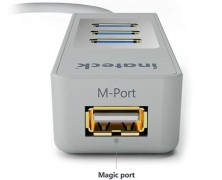Inateck is quickly rising up to become one of my favorite consumer electronics vendors. They make all kinds of relatively generic but still useful gear and they do it well. I last reviewed their FD2002 Dual Bay USB HDD Docking Station and their BP2001 Bluetooth Portable Speaker. Today, we’re taking a look at the HB4009 USB3.0 3-Port Hub +1 Magic-Port. My first thought was “what the hell is a Magic Port?” – Magic and IT are generally considered mutually exclusive, except when considering Clarke’s law: any sufficiently advanced technology is indistinguishable from magic. And perhaps when considering some of the arcane workarounds I’ve seen my colleagues come up with over the years, but that’s a story for another day. For the HB4009, the Magic Port enables cross-platform file transfers and KVM capabilities. The idea is you can connect it to two different PCs, or between your PC and your Android device to use it both as a glorified USB cable and as a KVM switch. It also boasts the ability to share the clipboard between devices and the included Mac KM Link software detects when the mouse reaches the border of any monitor and jumps it over to the other computer. The package comes with the hub itself, with one male USB cable coming out one end, 3 USB 3.0 ports and the magic port on the other end to attach the included male-to-male USB cable. It also includes a USB3.0 to MicroUSB adapter so you can connect the Magic port to your android devices. The USB hub and cable itself is about a foot long, with the male-to-male cable being an additional 3.93 feet. The first thing I tested was to make sure the USB hub actually worked, having minimal success with these things...
Inateck FD2002 Dual Bay USB 3.0 HDD Docking Station Review
posted by Josh Folland
The Inateck FD2002 is a dual-bay USB 3.0 HDD docking station. It’s plug and play, doesn’t require drivers and most interestingly has a built-in, offline clone function at the press of a button. Put drive into slot A, another into slot B (drive B must be equal or greater in size to drive A), press the clone button and it will copy the data over automatically (all you need to do is power the device, no computers required). Here’s the specifications from Inateck: Product Type Inateck FD2002 Weight 410 g / 0.903 lbs Offline Cloning Supported Supported Capacity Up to 4 TB Color Black Supported Drives 2.5″/3.5″ SATA I/II/III HDD/SSD Interface USB 3.0 Material Plastic Hot Plug, Plug & Play Supported Licenses CE, FCC Measurements 150 x 109 x 60 mm (L/W/H) 5.91 x 4.29 x 2.36 in (L/W/H) Operation Environment Storage: -40 to 70 °C; Operation: 5 to 55 °C OS Support XP/Vista/7/8(32/64-bit), Mac OS, Linux As someone who has worked on the bench and regularly tests hardware for not only benchmarking/performance purposes but maintenance as well, the FD2002 strikes me as an handy tool to have on-hand, especially if you’re in the business of swapping out and dealing with hard drives in bulk. The USB 3.0 “super speed” interface provides transfer rates and latencies comparable to a normal SATA connection. Hell, it even beat out the old Maxtor drives (left) I have inside my primary workstation: We used a pair of Seagate ST2000DL 2TB hard drives for our tests, which are 5900 RPM green drives. To see speeds like this out of a hard drive, let alone one running at a lower speed AND is attached externally is quite impressive. The Inateck FD2002 utilizes USB-attached SCSI (UAS) over traditional Bulk-Only Transport (BOT)...


